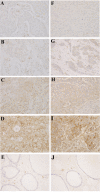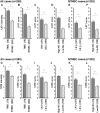Prognostic values of L-type amino acid transporter 1 and CD98hc expression in breast cancer
- PMID: 32907912
- PMCID: PMC8380907
- DOI: 10.1136/jclinpath-2020-206457
Prognostic values of L-type amino acid transporter 1 and CD98hc expression in breast cancer
Abstract
Aims: L-type amino acid transporter 1 (LAT1) is a major Na+-independent neutral amino acid transporter, forming a complex with CD98hc. The aim of this study is to investigate the significance of LAT1 and CD98hc in invasive breast cancer.
Methods: LAT1 and CD98hc expression was immunohistochemically assessed in 280 invasive breast cancers and analysed for association with clinicopathological features.
Results: High levels of LAT1 and CD98hc were observed in triple-negative breast cancers (TNBCs) possessing negative immunoreactivity with oestrogen receptor, progesterone receptor and human epidermal growth factor receptor 2, compared with non-TNBCs (NTNBCs), and were associated with lymph-node metastasis and higher nuclear grade. The high-LAT1-expression group showed a poor prognosis in NTNBC and TNBC, however, high-CD98hc-expression group showed a poor prognosis only in NTNBC. LAT1 and CD98hc expression could be the prognostic factors in univariate analyses, but not in multivariate analyses. Further, we found that invasive tumour components showed higher LAT1 and CD98hc expression than non-invasive tumour components.
Conclusions: LAT1 and CD98hc may possess prognostic values in invasive breast cancer. LAT1 may be linked with cancer cell activities and disease progression in breast cancer.
Keywords: breast cancer; breast pathology; histopathology.
© Author(s) (or their employer(s)) 2021. Re-use permitted under CC BY-NC. No commercial re-use. See rights and permissions. Published by BMJ.
Conflict of interest statement
Competing interests: HE is the Chief Executive Officer (CEO) and KH is an employee of J-Pharma, and both participated in this study with technical assistance.
Figures




Similar articles
-
Expression profile of CD98 heavy chain and L-type amino acid transporter 1 and its prognostic significance in colorectal cancer.Pathol Res Pract. 2022 Jan;229:153730. doi: 10.1016/j.prp.2021.153730. Epub 2021 Dec 2. Pathol Res Pract. 2022. PMID: 34942513
-
Prognostic significance of amino-acid transporter expression (LAT1, ASCT2, and xCT) in surgically resected tongue cancer.Br J Cancer. 2014 May 13;110(10):2506-13. doi: 10.1038/bjc.2014.178. Epub 2014 Apr 24. Br J Cancer. 2014. PMID: 24762957 Free PMC article.
-
The role of CD98 heavy chain in cancer development.Histol Histopathol. 2024 Dec;39(12):1557-1564. doi: 10.14670/HH-18-749. Epub 2024 Apr 16. Histol Histopathol. 2024. PMID: 38695393 Review.
-
Cryo-EM structure of the human L-type amino acid transporter 1 in complex with glycoprotein CD98hc.Nat Struct Mol Biol. 2019 Jun;26(6):510-517. doi: 10.1038/s41594-019-0237-7. Epub 2019 Jun 3. Nat Struct Mol Biol. 2019. PMID: 31160781
-
Prognostic Value of L-Type Amino Acid Transporter 1 (LAT1) in Various Cancers: A Meta-Analysis.Mol Diagn Ther. 2020 Oct;24(5):523-536. doi: 10.1007/s40291-020-00470-x. Mol Diagn Ther. 2020. PMID: 32410110 Review.
Cited by
-
miR-126 Decreases Proliferation and Mammosphere Formation of MCF-7 and Predicts Prognosis of ER+ Breast Cancer.Diagnostics (Basel). 2022 Mar 18;12(3):745. doi: 10.3390/diagnostics12030745. Diagnostics (Basel). 2022. PMID: 35328298 Free PMC article.
-
CD98 heavy chain as a prognostic biomarker and target for cancer treatment.Front Oncol. 2023 Sep 26;13:1251100. doi: 10.3389/fonc.2023.1251100. eCollection 2023. Front Oncol. 2023. PMID: 37823053 Free PMC article. Review.
-
The R-RAS2 GTPase is a signaling hub in triple-negative breast cancer cell metabolism and metastatic behavior.J Hematol Oncol. 2025 Apr 12;18(1):41. doi: 10.1186/s13045-025-01693-3. J Hematol Oncol. 2025. PMID: 40221767 Free PMC article.
-
Contribution of LAT1-4F2hc in Urological Cancers via Toll-like Receptor and Other Vital Pathways.Cancers (Basel). 2022 Jan 4;14(1):229. doi: 10.3390/cancers14010229. Cancers (Basel). 2022. PMID: 35008399 Free PMC article. Review.
-
Integrated analysis of FKBP1A/SLC3A2 axis in everolimus inducing ferroptosis of breast cancer and anti-proliferation of T lymphocyte.Int J Med Sci. 2023 Jun 26;20(8):1060-1078. doi: 10.7150/ijms.84872. eCollection 2023. Int J Med Sci. 2023. PMID: 37484811 Free PMC article.
References
MeSH terms
Substances
LinkOut - more resources
Full Text Sources
Medical
Research Materials
